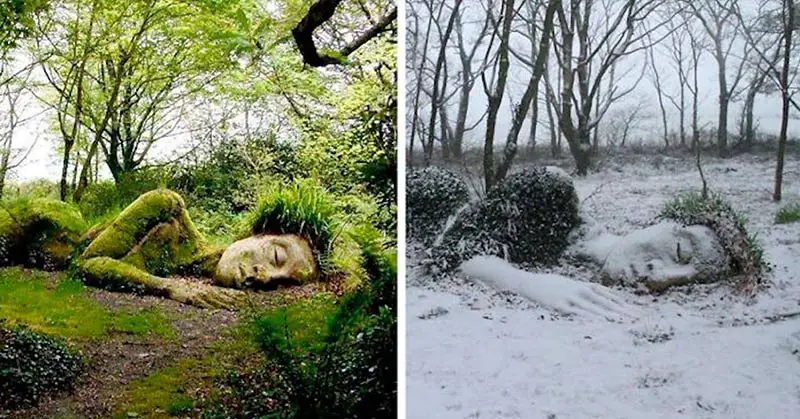Imagine taking a leisurely stroll through some vast and beautiful gardens, coming out into a clearing, and seeing what appears to be a giant woman sleeping peacefully in the grass.
That is what you will find in the Southwest of England, in the fairytale-like lands of Cornwall. The Mud Maid is a living sculpture that lies peacefully in the Lost Gardens of Heligan, and it is a sight to behold.
The Lost Gardens of Heligan
The Lost Gardens of Heligan belonged to the Tremayne Estate starting in the late sixteenth century. The gardens evolved and became increasingly extravagant throughout the subsequent generations, and by the nineteenth century, they were thriving. The gardens’ massive size required many hands, and by the beginning of the twentieth century, the estate employed 22 gardeners to look after them [1].
The outbreak of the First World War saw many of these employees leave for the front lines, and once the war was over their numbers had been so depleted that the gardens fell into disrepair. It wasn’t until 1990 that the gardens were rediscovered by a distant relative of the Tremayne family, and a campaign was set in motion to bring the gardens back to their former glory.
Under the guidance of lead architect Tim Smit, not only were the gardens restored but some floral art installations were commissioned, including the Giant’s Head and the Mud Maid. They have now become popular tourist attractions, and surrounding communities have benefited greatly from the increased tourism every year.
The gardens now feature all of the attractions they were originally known for, including massive rhododendrons, the Italian gardens, and the jungle gardens. There are also vegetable gardens on the massive property, which grow large amounts of produce for sale [1].
The Living Sculpture
The Mud Maid was commissioned in 1997 and has become an integral part of the gardens ever since. Created by brother-sister duo Pete and Sue Hill, the Mud Maid is a “living sculpture” because her clothes and hair, which are made of grass, ivy, and moss, change throughout the seasons as they grow and die [2].

The sculpture was built using a framework of hollow timber and windbreak netting, which was then covered in sticky mud, and the face was made from a mixture of mud, cement, and sand. The head is full of Woodsedge and Montbretia, to give the appearance of hair, while the body is covered in ivy to make up her clothes.
Initially, the sculpture was actually covered in yogurt to encourage the growth of lichens over the body.

The Mud Maid, along with the Giant’s Head, was created with the purpose of adding a sense of mystery to the gardens, a task they have accomplished quite successfully. In the spring, the sleeping woman is bright, covered in green mosses, grasses, and ivy, but as the weather turns colder, the bright green gives way to darker, more autumnal colors. The winter is arguably the eeriest when most of her plant cover has died off, and a light dusting of snow sits in its place [2].

Read: Yard-Sale Bowl Revealed To Be Rare Artifact Worth Up To $500,000
Visit the Gardens
The Heligan gardens span two hundred acres, so you will want to set aside a large amount of time if you want to explore them properly.
The gardens feature trails and an adventure playground where children can participate in additional activities including den building, storytelling, and craft workshops. A stroll through the Woodland Walk will bring you past the Mud Maid, the Giant’s Head, and the Grey Lady, and the wobbling Burmese rope bridge will provide more adventurous visitors with a thrill.
You can bring along your own picnic lunch to set up at any number of scenic picnic spots, or you can grab a hot or cold meal or sandwich from the Heligan Kitchen or Steward’s House for as little as two to five euros.
The gift shop, if you choose to visit it, features toys, jewelry, crafts, organic skincare products, and candies made by local artisans, or sometimes by the staff right on site. Entrance is free for children under five years old, and ranges from 6.50 euros to 14.50 euros depending on age, with discounts for students and seniors.
The gardens are open every day of the year except Christmas, although hours vary depending on the season. Whatever time of year you choose to go, however, you will be met with magic, mystery, and fantasy at every turn [3].
The gardens have been closed due to the COVID-19 pandemic, but are scheduled to re-open soon. For more information, check out their website.
Keep Reading: Giant ‘Serpent’ Emerges From the Sea Off the Coast of France
Sources
- “Lost Gardens of Heligan.” Atlas Obscura
- “Incredible Living Sculpture In The Lost Gardens Of Heligan Changes Its Appearance With The Seasons.” Bored Panda. 2020.
- “Take the kids to … the Lost Gardens of Heligan, Cornwall.” The Guardian. Kari Herbert. February 7, 2018.

